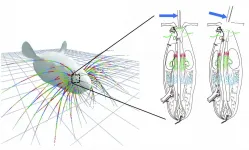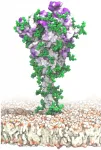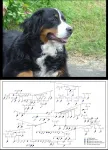(Press-News.org) Telehealth has become a critical way for doctors to still provide health care while minimizing in-person contact during COVID-19. But with phone or Zoom appointments, it's harder for doctors to get important vital signs from a patient, such as their pulse or respiration rate, in real time.
A University of Washington-led team has developed a method that uses the camera on a person's smartphone or computer to take their pulse and respiration signal from a real-time video of their face. The researchers presented this state-of-the-art system in December at the Neural Information Processing Systems conference.
Now the team is proposing a better system to measure these physiological signals. This system is less likely to be tripped up by different cameras, lighting conditions or facial features, such as skin color. The researchers will present these findings April 8 at the ACM Conference on Health, Interference, and Learning.
"Machine learning is pretty good at classifying images. If you give it a series of photos of cats and then tell it to find cats in other images, it can do it. But for machine learning to be helpful in remote health sensing, we need a system that can identify the region of interest in a video that holds the strongest source of physiological information -- pulse, for example -- and then measure that over time," said lead author Xin Liu, a UW doctoral student in the Paul G. Allen School of Computer Science & Engineering.
"Every person is different," Liu said. "So this system needs to be able to quickly adapt to each person's unique physiological signature, and separate this from other variations, such as what they look like and what environment they are in."
The team's system is privacy preserving -- it runs on the device instead of in the cloud -- and uses machine learning to capture subtle changes in how light reflects off a person's face, which is correlated with changing blood flow. Then it converts these changes into both pulse and respiration rate.
The first version of this system was trained with a dataset that contained both videos of people's faces and "ground truth" information: each person's pulse and respiration rate measured by standard instruments in the field. The system then used spatial and temporal information from the videos to calculate both vital signs. It outperformed similar machine learning systems on videos where subjects were moving and talking.
But while the system worked well on some datasets, it still struggled with others that contained different people, backgrounds and lighting. This is a common problem known as "overfitting," the team said.
The researchers improved the system by having it produce a personalized machine learning model for each individual. Specifically, it helps look for important areas in a video frame that likely contain physiological features correlated with changing blood flow in a face under different contexts, such as different skin tones, lighting conditions and environments. From there, it can focus on that area and measure the pulse and respiration rate.
While this new system outperforms its predecessor when given more challenging datasets, especially for people with darker skin tones, there's still more work to do, the team said.
"We acknowledge that there is still a trend toward inferior performance when the subject's skin type is darker," Liu said. "This is in part because light reflects differently off of darker skin, resulting in a weaker signal for the camera to pick up. Our team is actively developing new methods to solve this limitation."
The researchers are also working on a variety of collaborations with doctors to see how this system performs in the clinic.
"Any ability to sense pulse or respiration rate remotely provides new opportunities for remote patient care and telemedicine. This could include self-care, follow-up care or triage, especially when someone doesn't have convenient access to a clinic," said senior author Shwetak Patel, a professor in both the Allen School and the electrical and computer engineering department. "It's exciting to see academic communities working on new algorithmic approaches to address this with devices that people have in their homes."
INFORMATION:
Ziheng Jiang, a doctoral student in the Allen School; Josh Fromm, a UW graduate who now works at OctoML; Xuhai Xu, a doctoral student in the Information School; and Daniel McDuff at Microsoft Research are also co-authors on this paper. This research was funded by the Bill & Melinda Gates Foundation, Google and the University of Washington.
For more information, contact Liu at xliu0@cs.washington.edu and Patel at shwetak@cs.washington.edu.
SEATTLE (April 1, 2021) - An international consortium of geneticists, biologists, clinicians, mathematicians, and other scientists is determined to take the study of the human genome to the next level - creating a comprehensive atlas of genetic variants to advance the understanding, diagnosis, and treatment of disease.
"This Herculean undertaking is unprecedented," said Dr. Matthew Hurles, a geneticist at the Wellcome Sanger Institute in Cambridge, England. "Indeed, the scientific community has an increasingly comprehensive catalog of functional DNA elements in the human genome, but that catalog remains incomplete. We have collectively characterized the functional impact of less than 1% of genetic variation in the 1 to 2 percent of our DNA."
Hurles and Dr. Doug Fowler, a member of the ...
Exposure to antibiotics in utero and infancy can lead to an irreversible loss of regulatory T-cells in the colon-a valuable component of the immune system's response toward allergens in later life - after only six months, a Rutgers researcher found.
The study was published in the journal mBio.
It is already known that the use of antibiotics early in life disrupts the intestinal microbiota - the trillions of beneficial microorganisms that live in and on our bodies - that play a crucial role in the healthy maturation of the immune system and the prevention of ...
Video games offer students obvious respite from the stresses of studies and, now, a study from a University of Ottawa medical student has found they could benefit surgical skills training.
Arnav Gupta carries a heavy course load as a third-year student in the Faculty of Medicine, so winding down with a game of Legend of Zelda always provides relief from the rigorous of study. But Zelda may be helping improve his surgical education, too, as Gupta and a team of researchers from the University of Toronto found in a paper they recently published in the medical journal ...
East Hanover, NJ. April 1, 2021. A team of New Jersey researchers has shown that changes in perceptual certainty and response bias, two central metrics of signal detection theory (SDT), correlate with changes in cognitive fatigue. They also show that SDT measures change as a function of changes in brain activation. This finding was reported in Frontiers in Psychology on January 15, 2021, in the open access article "Using Signal Detection Theory to Better Understand Cognitive Fatigue" (doi:10.3389/fpsyg.2020.579188).
The authors are Glenn Wylie, DPhil, Brian Yao, PhD, and John DeLuca, PhD, of Kessler Foundation, and Joshua Sandry, PhD, of Montclair State ...
Researchers have developed a new mechanical model that simulates how whiskers bend within a follicle in response to an external force, paving the way toward better understanding of how whiskers contribute to mammals' sense of touch. Yifu Luo and Mitra Hartmann of Northwestern University and colleagues present these findings in the open-access journal PLOS Computational Biology.
With the exception of some primates, most mammals use whiskers to explore their environment through the sense of touch. Whiskers have no sensors along their length, but when an external force bends ...
A new, detailed model of the surface of the SARS-CoV-2 spike protein reveals previously unknown vulnerabilities that could inform development of vaccines. Mateusz Sikora of the Max Planck Institute of Biophysics in Frankfurt, Germany, and colleagues present these findings in the open-access journal PLOS Computational Biology.
SARS-CoV-2 is the virus responsible for the COVID-19 pandemic. A key feature of SARS-CoV-2 is its spike protein, which extends from its surface and enables it to target and infect human cells. Extensive research has resulted in detailed static models of the spike protein, but these models do not capture the flexibility of the spike protein itself nor the movements of protective glycans--chains ...
Six genetic variants add up to determine the risk of several blood cancers in pre-disposed dog breeds, according to a study by Benoît Hédan at the University of Rennes and colleagues, publishing April 8th in the open-access journal PLOS Genetics. The results confirm a known tumour-suppressor gene as a risk factor for histiocytic sarcoma -- a rare and aggressive blood cancer that affects both dogs and humans -- as well as identifying four new genetic loci associated with the disease.
The researchers sequenced genomic DNA extracted from blood samples from Bernese mountain dogs, Rottweilers, flat-coated retrievers, and golden retrievers, including ...
Memory loss is common after general anesthesia, particularly for events occurring immediately before surgery--a phenomenon called retrograde amnesia. But a new study publishing on April 1st 2021 in the open access journal PLOS Biology, led by Simon Wiegert at the University Medical Center Hamburg-Eppendorf in Germany, shows that changes in the hippocampus--the part of the brain used to make new memories--differ depending on which general anesthetic is used. Consequently, their effects on memory formation also differ.
Understanding how different anesthetics affect the brain, particularly the hippocampus, is therefore important for both clinicians with human patients and experimental scientists who work with animals. Wiegert and his team recorded brain activity from the hippocampus ...
Achuta Kadambi, an assistant professor at the UCLA Samueli School of Engineering, published a column in the journal Science about how medical devices can be fundamentally biased -- not just in dataset representation as has been widely reported, but from a deeper root: the laws of physics.
Kadambi described how the inherent physics behind medical devices could vary across race and gender. He cited several examples of potential physics-based bias. For example, recent research has shown that a pulse oximeter -- a medical device typically placed on a fingertip that uses infrared and light beams to measure oxygen saturation of the blood and the pulse rate -- is more likely to miss low levels in people with darker skin.
What motivated Kadambi to write this piece stemmed from ...
A group of scientists from the University of Koblenz-Landau, Germany, has shown that for plants and insects the applied pesticide toxicity in agriculture has substantially increased between 2004 and 2016. In a paper published in the current issue of Science, the authors show that this pattern is even relevant in genetically modified (GM) crops that were originally designed to reduce pesticide impacts on the environment.
"We have taken a large body of pesticide use data from the US and have expressed changes of amounts applied in agriculture over time as changes in total applied pesticide toxicity," says lead author Ralf Schulz, professor for environmental sciences in Landau. "This provides a new view on the potential ...






